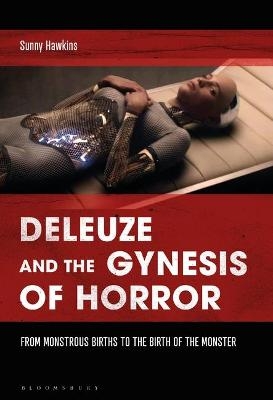
Deleuze and the Gynesis of Horror
From Monstrous Births to the Birth of the Monster
Seiten
2020
Bloomsbury Academic USA (Verlag)
978-1-5013-5845-6 (ISBN)
Bloomsbury Academic USA (Verlag)
978-1-5013-5845-6 (ISBN)
Applying Deleuze’s schizoanalytic techniques to film theory, Deleuze and the Gynesis of Horror demonstrates how an embodied approach to horror film analysis can help us understand how film affects its viewers and distinguish those films which reify static, hegemonic, “molar” beings from those which prompt fluid, nonbinary, “molecular” becomings. It does so by analyzing the politics of reproduction in contemporary films such as Ex Machina; Mary Shelley’s Frankenstein; Mad Max: Fury Road; the Twilight saga; and the original Alien quadrilogy and its more recent prequels, Prometheus and Alien: Covenant.
Author Sunny Hawkins argues that films which promote a “monstrous philosophy” of qualitative, affirmative difference as difference-in-itself, and which tend to be more molecular than molar in their expressions, can help us trace a “line of flight” from the gender binary in the real world. Deleuze and the Gynesis of Horror demonstrates how the techniques of horror film – editing, sound and visual effects, lighting and colour, camera movement – work in tandem with a film’s content to affect the viewer’s body in ways that disrupt the sense of self as a whole, unified subject with a stable, monolithic identity and, in some cases, can serve to breakdown the binary between self/Other, as we come to realize that we are none of us static, categorizable beings but are, as Henri Bergson said, “living things constantly becoming.”
Author Sunny Hawkins argues that films which promote a “monstrous philosophy” of qualitative, affirmative difference as difference-in-itself, and which tend to be more molecular than molar in their expressions, can help us trace a “line of flight” from the gender binary in the real world. Deleuze and the Gynesis of Horror demonstrates how the techniques of horror film – editing, sound and visual effects, lighting and colour, camera movement – work in tandem with a film’s content to affect the viewer’s body in ways that disrupt the sense of self as a whole, unified subject with a stable, monolithic identity and, in some cases, can serve to breakdown the binary between self/Other, as we come to realize that we are none of us static, categorizable beings but are, as Henri Bergson said, “living things constantly becoming.”
Sunny Hawkins is the Director of Peer Tutoring and Writing Across the Curriculum at Butler University in Indianapolis, USA, where she teaches seminars on Gender and Horror Film. She holds a PhD in English from Southern Illinois University Carbondale and has served as an Associate Professor of English at the University of Southern Indiana and Texas A&M University-Kingsville, USA. Her work on horror film has appeared in the interdisciplinary journal Reconstruction.
1. Mother, (m)Other
2. Mother (of) Monsters
3. Meet Your Makers
4. It’s a Monster (Baby)
5. The Post-Human Family
Bibliography
Index
| Erscheinungsdatum | 02.10.2020 |
|---|---|
| Verlagsort | New York |
| Sprache | englisch |
| Maße | 152 x 229 mm |
| Gewicht | 445 g |
| Themenwelt | Kunst / Musik / Theater ► Film / TV |
| Sozialwissenschaften ► Kommunikation / Medien ► Medienwissenschaft | |
| Sozialwissenschaften ► Soziologie ► Gender Studies | |
| ISBN-10 | 1-5013-5845-6 / 1501358456 |
| ISBN-13 | 978-1-5013-5845-6 / 9781501358456 |
| Zustand | Neuware |
| Haben Sie eine Frage zum Produkt? |
Mehr entdecken
aus dem Bereich
aus dem Bereich
wie KI und virtuelle Welten von uns Besitz ergreifen – und die …
Buch | Hardcover (2023)
Heyne (Verlag)
CHF 29,90
eine jüdische Filmgeschichte der Bundesrepublik
Buch | Hardcover (2023)
Hanser (Verlag)
CHF 39,20


